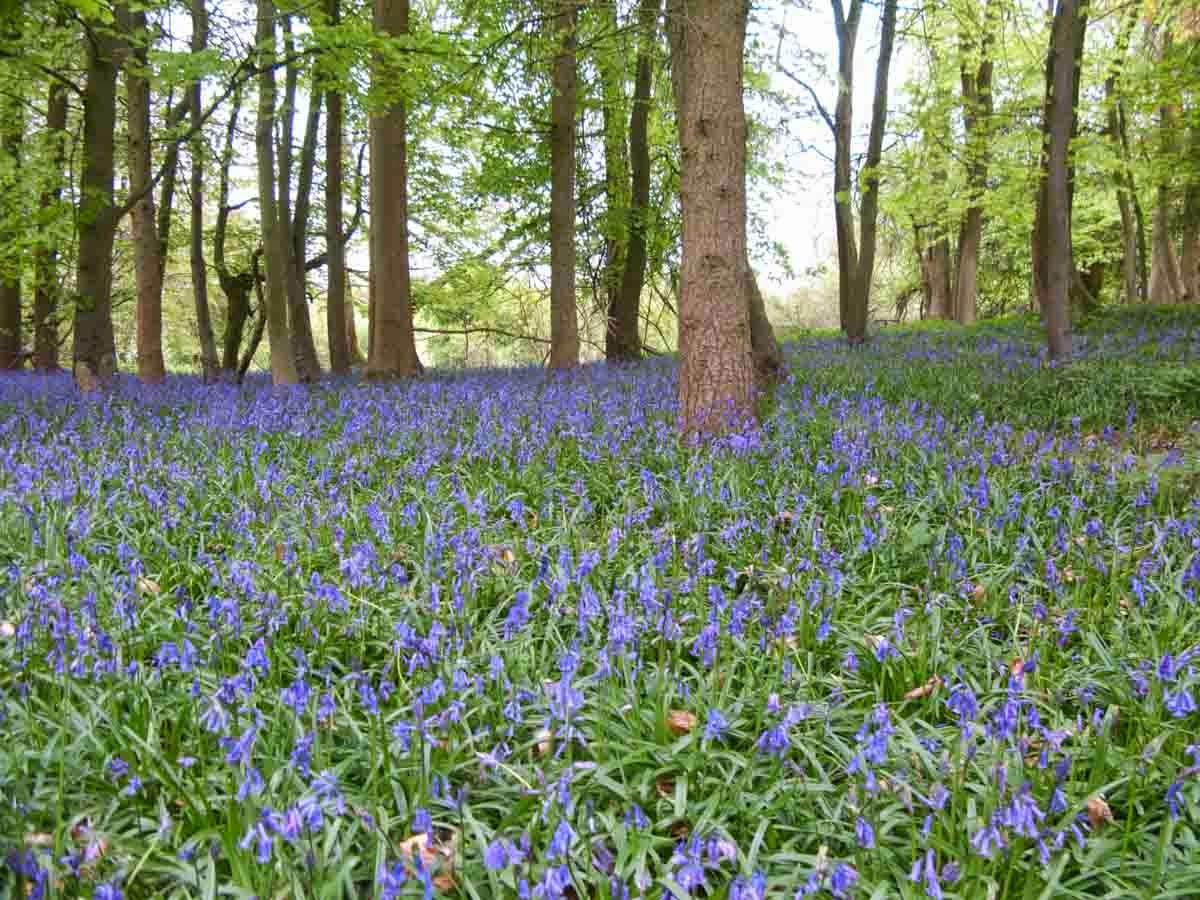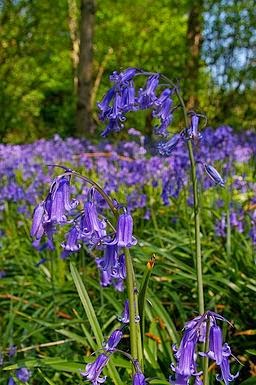by Helen Roberts
It is a beautiful spring morning in May and I am taking my children for a walk. We are venturing to some local woods on the edge of the Mendip Hills, a stone’s throw away from our house.
The woods are secreted away in a limestone gorge. The stubby cliffs of limestone are clothed in ivy and gradually open up into a steep sided valley. A tiny stream channels through the gorge; tributaries often disappearing down sink holes. We trek across a ploughed field to the gate that lets us into the wood.
As we pass through the kissing gate, there is an overwhelming smell – it’s the heady perfume of the native bluebell, Hyacinthoides non-scripta. The woods are carpeted in vibrant blue (the colour almost glows it is so vivid), dotted with ferns and intermingled with wood anemones (Anemone nemorosa), Lady’s smock (Cardamine pratensis), wild garlic (Allium ursinum), greater stitchwort (Stellaria holostea) and yellow archangel (Lamiastrum galeobdolon). It is one of my favourite places for a walk in the spring and it is made special because of the sight and smell of bluebells.
Bluebell woods in Britain are under threat

Bluebells blanket the ground in British woodlands
this time of year. Photo credit: Shelby Temple

| Bluebells blanket the ground in British woodlands this time of year. Photo credit: Shelby Temple |
Bluebell woods are an iconic part of our natural heritage and are one of the most beautiful sights to encounter in the British countryside. They were voted Britain’s favourite flower in Plantlife’s ‘CountyFlowers’ project in 2002 and we have 50% of the entire world population in our country.
Sadly, the indigenous bluebell, Hyacinthoides non-scripta, is in danger because it cross breeds with the commonly planted Spanish bluebell (Hyacinthoideshispanica) and with the resulting fertile hybrid (Hyacinthoides x massartiana). Molecular studies have shown that the Spanish bluebell and the native bluebell have a shared ancestor [1], but Hyacinthoides non-scripta has developed in isolation over the last 8,000 years, its range to the north of the Spanish bluebell [2].
Polluting bluebell genetics
The Spanish bluebell has been grown as a garden plant in Britain since 1683 [3] and it and its hybrid have now ‘gone over the garden wall’ and are encroaching on our native bluebell woods. Its leap over the ‘wall’ has most likely been facilitated by bulbs being thrown out or dumped near native woodlands. The Spanish bluebell looks a thug of a plant next to our native one – being a much bigger plant – and is reported far more vigorous.
In its native range, the Spanish bluebell has a wider ecological tolerance to that of the native bluebell. It copes better with drier and more exposed conditions and can therefore grow in more open sites, such as roadside verges and waste ground. The Spanish bluebell is a garden favourite because it’s so much larger and can establish itself and grow quickly. Both the Spanish bluebell and its hybrid, however, have the ability to take over leading to the loss of genetic integrity of the native bluebell.
The native and bluebell hybrid are really difficult to tell apart even by expert botanists and sometimes the only way to distinguish between them is to apply DNA analysis. Many gardeners are sold the hybrid mislabeled as ‘English Bluebell’ and have planted them in good faith thinking these were the native bluebell.
The hybrids were first recorded in the wild in 1963, though they were likely there long before then as the Spanish bluebell was first recorded in the wild in 1909. The Natural History Museum gives good guidance on how to identify your bluebells with a supporting video given by botanist Fred Rumsey here.
Nation-wide bluebell surveys show extent of Spanish bluebell invasion
A survey performed by Plantlife International in 2003 found that one in six broadleaved woodlands surveyed were found to contain the hybrid or Spanish bluebell. The survey drew attention to the threat posed to our native bluebell as well as the need for more research in order to better understand species distribution, gene transfer across species and appropriate horticultural management of bluebell species.
Thankfully, it has been illegal (without a license) for anyone to collect and sell native bluebells from the wild since 1998 as they are protected under the Countryside and Wildlife Act (1981). Current legislation allows for the issuing of a special license to collect wild seed for commercial sale. These safeguards ensure that collection is done sustainably and protects wild bluebell populations.
The native bluebell is a priority species under the UK BiodiversityAction Plan (BAP). Plantlife International states that it’s vital that the horticultural industry stop the deceiving sale of the Spanish and hybrid bluebell as native bluebell. Plantlife has also worked with Flora Locale to set up an industry code of practice. Flora Locale helps people get in touch with suppliers in their area who sell seeds of local provenance. Another initiative between Landlife and the Mersey Forest produces a legitimate source of bulbs grown from seed with a long term programme running to plant them in new woodlands. Plantlife International also gives advice about making sure that gardeners check suppliers of bluebells and how to remove Spanish or hybrid bluebells from your land – read more here.
The Natural History Museum launched a bluebell survey in 2006 (of which you can take part) to look at the extent to which non-native bluebells have spread into the British countryside. Results from the last eight years show that most bluebells in urban areas are now hybrids, but fortunately there are still large areas of countryside containing our native species.
Since 2010, the survey has concentrated on comparing the flowering times of native and non-native bluebells to understand how they will each respond to climate change. By comparing recent surveys with past data, it is possible to find out whether the flowering season is changing. These data need to be collected over many years in order to tease out any real effects of climate change from the natural fluctuations inherent in any population.
Sources:
[1] Grundmann, M. et al. (2010). Phylogeny and taxonomy of the bluebell genus Hyacinthoides, Asparagaceae [Hyacinthaceae]. Taxon, 59 (1): 68-82.
[2] Natural History Museum [website] Hyacinthoides non-scripta (British bluebell). http://www.nhm.ac.uk/nature-online/species-of-the-day/biodiversity/endangered-species/hyacinthoides-non-scripta/
[3] Pilgrim, E. and N. Hutchinson. Bluebells for Britain: A report on the 2003 Bluebells for Britain survey. Plantlife International. <http://www.plantlife.org.uk/uploads/documents/Blubells-for-Britain-report.pdf>
More sources of information on bluebells:
Preston C.D. et al. (2002). New Atlas of the British and Irish Flora: An Atlas of the Vascular Plants of Britain, Ireland, The Isle of Man and the Channel Islands. ISBN: 9780198510673. [Provides information on each taxon]
Tines T.D.. et al. (2012). The Wild Things Guide to the Changing Plants of the British Isles. ISBN: 9781905026999. [Provides information on the spread of non-native bluebells]


.jpg)